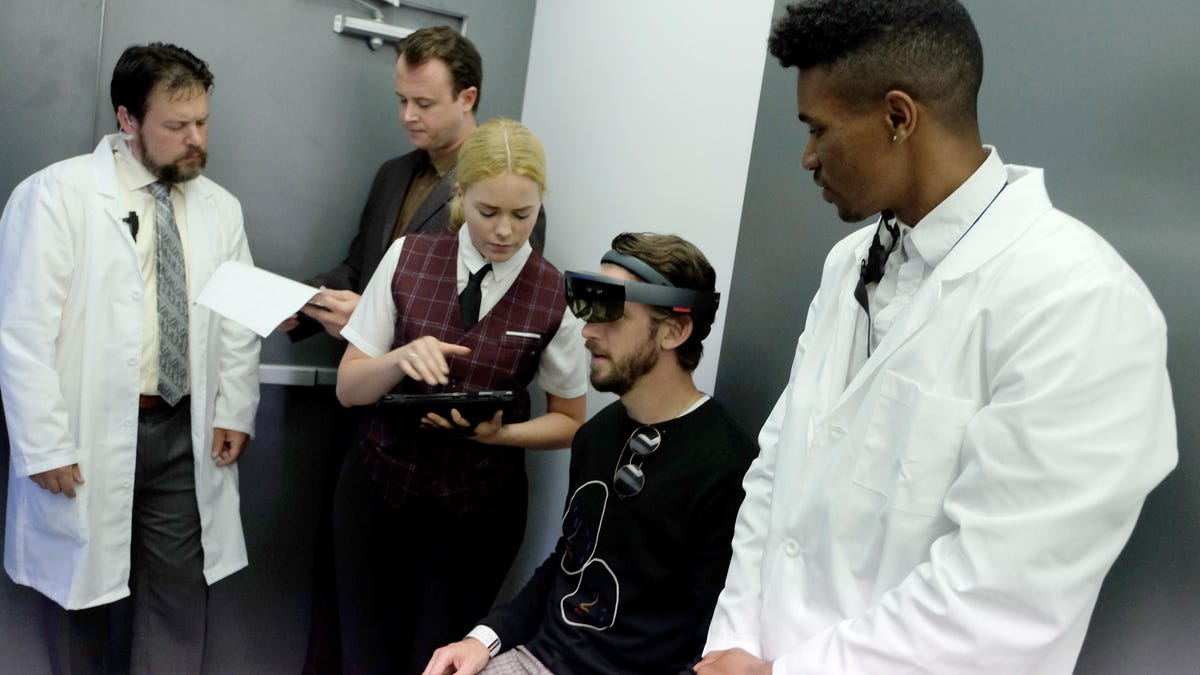Reality-bending 'Legion' game has what every escape room needs
Futuristic entertainment plunges you into the action of upcoming TV shows and movies. We tried lots of these mixed-reality experiences at Comic-Con.
Two attendants usher me inside a building that looks equal parts hospital and prison, staring me down like I'm some kind of freak.
They place a transparent headset on me, and I'm put through a series of tests so they can determine whether I'm a danger to myself. All the while, voices play inside my head, telling me how to use my psychic powers to escape this intense setup.
My bracelet says my name is David Haller, the main character from the FX series "Legion" based on an X-Men-related comic book character, and with Microsoft's HoloLens headset combined with these excellent actors on a real-life set, I've truly become part of the show.
I choose how I want to speak to the actors, and they coldly ask me to use my powers to make objects (which I can only see through the HoloLens) float. The speakers inside the headset give me further directions as allies "telepathically" guide me through this tense scenario.
Man, it's heavy, and I absolutely want to do it again.
The HoloLens can place virtual objects in your field of vision, which Microsoft has previously shown off with Halo and Minecraft-themed concepts. But in this case, the objects, combined with the in-person acting, enhanced the idea that I was the powerful X-Man struggling through this. Frankly, every escape room-type experience could use this kind of augmented-reality immersion -- you are still seeing the real world as it's playing out, but through the HoloLens you also see fantastical elements digitally added in.
This "Legion"-themed experience was set up just outside of San Diego Comic-Con, one of many virtual and augmented-reality experiences last week that offered passerby a chance to immerse themselves in upcoming TV shows and movies.
Inside a nearby hotel was VR Con, an event focusing squarely on experiences like this. There, Digital Domain was highlighting its animated tale, "Monkey King," which will be released first on PlayStation VR on July 26 before coming to other headsets and stores later on.
You can watch Digital Domain's "Monkey King" like a play from inside a headset.
This feature looks and feels like a cartoon you might otherwise watch on a network like Nickelodeon, but virtual reality gives the audience member a fixed place to view the action from.
Dock an iPhone into Mira's headset and it will project virtual objects all around you.
"We try to keep in mind that people can look everywhere they want, but we do want to focus on the action," said Wayne Kennedy, director of creative content at Digital Domain. He said his team made use of music to help cue the viewer toward the action.
While viewers do not influence the story like they would in a game, they can pick up on elements like a character hiding in the background before walking toward the main character... much like watching a stage play.
The Mira Prism headset aims for a similar experience to the HoloLens, making use of the player's phone to help project the headset's augmented-reality games.
In the case of the VR Con demo, players could fly a spaceship at planets that are projected all around you, so you need to turn while piloting a ship with a handheld controller.
Other reality experiences at Comic-Con aimed to be more like a ride.
Outside in a scary-looking school bus was an experience for the "It" film, one that first places people inside of a cramped space while you hear Pennywise the clown's menacing laugh.
The "It" VR experience places you inside of a creepy bus bound for a trip into Pennywise the clown's sewer.
After a few minutes of waiting in this dark space, the door opened, revealing rumbling chairs where you sit and strap on a Samsung Gear VR headset, during which viewers are taken on a bloody tour through the sewers in search of a missing child.
A couple of jump scares are sprinkled into this noninteractive experience, giving a sense of tone for the movie and perhaps a pitch as to what a theme park version of "It" could feel like.
And in the case of "Blade Runner 2049," all of these approaches were combined to create the immersive effect of riding into a post-apocalyptic version of Los Angeles.
While the physical car ride into the city was a virtual experience, when you took off the headset you found yourself in a living, breathing version of the city that will be a focus of the movie (Read more about the "Blade Runner 2049" experience here.)
This level of immersion is exciting. Maybe in a few years we won't just be waiting for Comic-Con to see the future of movies, we could be at home seeing the future of personalized theater that uses virtual and augmented reality to reel you in.
Comic-Con 2017: Full coverage of the fantasy-fan freak-out.
Tech Culture: From film and television to social media and games, here's your place for the lighter side of tech.


